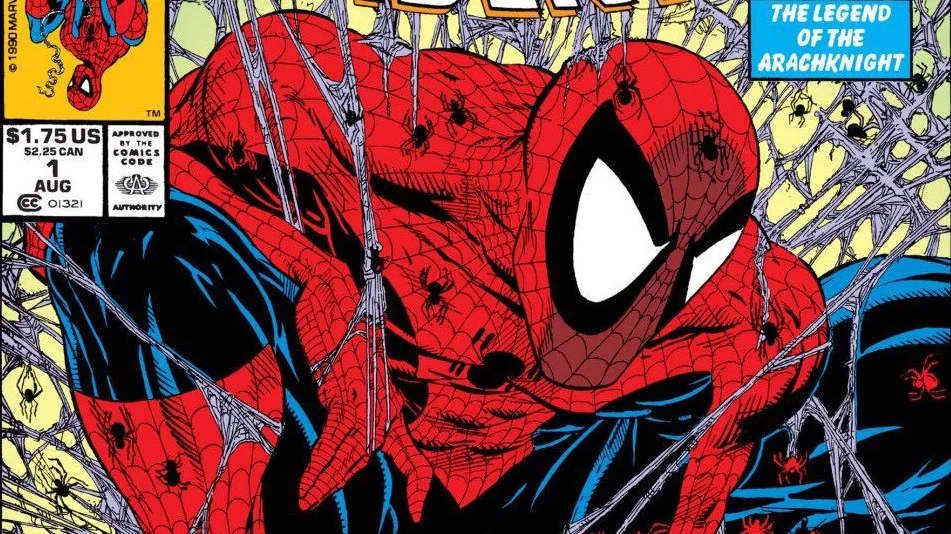Todd McFarlane and Spider-Man, Inseperable As Peanut Butter and Jelly

There have been so few artists that are as synonymous with a character as Todd McFarlane and Spider-Man. Not only did he revitalize the character through his art, he also introduced the world to one of his most iconic villains in Venom.
Born in 1961, McFarlane immediately took an interest in drawing comic book characters. By the time he finished college, he found himself working with a few publishers. Most notably of these, Marvel. While at Marvel he was assigned a job both exciting and terrifying…Spider-Man.
The days of Todd McFarlane and Spider-Man were just beginning.
It was a strange time for the industry.
At Marvel, Chris Claremont and his ‘X’ titles reigned supreme. From X-Men and Excalibur to every other ‘X’ title that can be thought of, his books were the equivalent of today’s MCU. Nothing was bigger and more widely respected.
The industry was just a few years ahead of its collapse. Variant covers were just beginning and as such, not had to the time to damage the industry in the ways we now know. Collectors were beginning to realize that there was value in comics and for the first time, comics were perceived as more than just a childish pastime.
Finally, the industry was a couple years away from seven comic books artists walking away for their publishers for bigger things. Image Comics, at this time, wasn’t even a thought.
Status quo
Spider-Man #1 was a step away from the status quo. First, for the first time in
Second, unlike what traditionally happens, the creator, Todd McFarlane was given control and allowed to write what he wanted to write. Marvel had done this a few times in the past, all to varying results, but never on a title like Spider-Man. Aside from X-Men, he was their Golden Boy.
The issue launched in 1990 and with it, began a trend that crippled the industry.
Feeding frenzy
The book released alongside a few other titles, however, none of these were given the treatment Spider-Man received. It debuted with two different covers and poly bagged variants for each.
The race was on for collectors to scoop up what they could. And they did. Fans flooded the stores in droves to get their hands on the relaunch of Spider-Man and its variants. The dealers, stores, and distributors didn’t seem to care. Each drove prices sky high claiming riches beyond imagination for any who snagged a copy. Fans and non-fans alike smelled money and the greed of the industry made the book catch like a wildfire.
This was just a small taste of what was to come.
Upon its release, Spider-Man #1 sold over 2,000,000 copies. Within weeks books that should sell for $1.00 were selling for $20.00. And the insanity was just beginning.
Elevation
Spider-Man #1, more than any book before it, elevated the importance of the art to the title. Marvel and DC spent their entire existence creating stories that catered to their readers. Their readers in turn, bought the stories and waited with baited breath for the next months issue.
Readers in the late 1980’s and early 1990’s were a different breed. Not only did they want more, they demanded more. Art mattered and the sales of the books showed this.
As a result, “hot” artists were given their own titles. There is no finer example than Jim Lee. In 1991, Lee was given X-Men and he turned it into 6,000,000 copies sold, no pun intended juggernaut.
Spider-Man #1 was a trailblazer when the industry needed it most. It placed the world’s eyes firmly on comics and for the first time in a long time, comics were the “it” thing. While this may have looked great from the outside, it wasn’t. Because of it, the industry changed from function over form to form over function. The books became less about content and more about looks.
Character defining
From an aesthetic point of view, McFarlane changed what it was to be Spider-Man. Before his time, the wallcrawler was a relatively straightforward hero. To draw Spider-Man was a task that a child could grasp. McFarlane did many important things to the character. None of which are more important than the way in which the eyes and webbing were drawn.

When he was done, the character’s eyes had changed in three important ways. First, he enlarged them. Second, he outlined them in deep, dark black lines. And third, he gave them expression. Before his time, Spider-Man’s eyes were practically incapable of expressing emotion. After McFarlane, the audience could practically see when he was crying underneath the mask.
Then there’s the webbing…
McFarlane has stated that after he did the webs, the executives told him to knock it off. That the world wasn’t ready for the new webs and that it deviated too far away from the traditional. Boy, were they wrong. This, like an unruly child acting out, prompted him to add more.
Due to its look, It’s been called “spaghetti webbing”. Fans called it, welcomed. It made sense. Spiders put webs together by twining tiny strands together. Why shouldn’t Spider-Man do the same? Why shouldn’t his webs look like they came from, well, a spider?
It wasn’t Todd McFarlane and Spider-Man, it was Todd McFarlane is Spider-Man.
It wasn’t just about the webs though. McFarlane was embracing the way that children and teenagers were already living.
Rebellion
Ripped jeans, video games, backwards hats, and curfew-breaking rebellion. Kids, through outlets that had never been available before, were rebelling at a rate unheard of.
I believe that McFarlane knew this and he played into it. His writing needed work but his drawing was new and fresh. It was edgy, dark, and broke nearly every tradition that was breakable.
And children couldn’t get enough of it. They ate it up the same way I eat peanut butter; as quickly as possible.
At the end of the day, Spider-Man #1 was the shake up the industry so desperately needed. Nobody could’ve predicted how much things would change as a consequence. Even today, very few books have done what it did.
It sent the industry to an all-time high and ushered in a dark age, both figuratively and commercially. There may never be a book like it again. As such, there is no denying Todd McFarlane and Spider-Man their place as a pivotal point in comic book history.
What do you think? Is t
Cheers,
Joel

